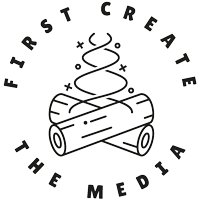Written by Kat Arney, Chief Creative Officer. Last updated July 2025.
First Create The Media is a communications strategy and content agency specialising in the life sciences. We help pioneering bioscience companies grab the attention of the audiences that matter.
We’re excited by the potential of artificial intelligence (AI) to augment our digital tools and allow us to do even more, particularly generative AIs that can create new things based on information they have been given.
We use a wide range of digital technologies that enable us to function efficiently to deliver the high quality, value-added work our clients expect and deserve in a cost-effective way. Increasingly, these tools include AI functionality, including generative AI capabilities.
Led by our values of quality, understanding, integrity and respect, we aim to understand what these new tools can do and how they work, their limitations and risks, and how we can utilise them in a safe and ethical way.
Here’s a rundown of how we currently use AI-enhanced tools at First Create The Media to support our client work and our own communications, and the principles we adhere to.
Writing and research
Generative AI writing and research tools based on large language models (LLMs), including Chat GPT, Gemini, NotebookLM and Perplexity have a number of functions such as generating, manipulating and summarising text, based on information they have previously been trained on or given.
For example, AI tools are useful for generating summaries of source material or as a starting point for researching a topic based on existing published information. We also use them for idea generation and testing, in much the same way that we would bounce ideas around with colleagues.
We ask them for outlines and points that should be included in particular pieces of content, and to suggest what we might be missing, as well as advice on search engine optimisation (SEO) such as format, titles and subtitles.
And we use AI for creating social media posts – for example, repurposing or reformatting existing content that we have previously produced, or for creating initial drafts that we then refine.
However, we have significant concerns around the accuracy, creativity and originality of the text produced by these tools, particularly for scientific topics or content that is highly specific to individual clients. Additionally, there is a lack of clarity about issues related to copyright assignment or infringement, and data confidentiality.
We believe the value we add as skilled writers and experienced comms professionals is not in churning out low quality, generic copy with AI, but in our strategic understanding of our clients’ goals, preferences, and work, and creating high quality creative science-led communications that are tailored to their unique needs and consistently reflect their values and brand.
In our experience, this is something that AI tools just can’t deliver to the standard we demand. We will always check, adapt and rewrite any AI-generated text, often extensively, before it goes through our internal quality control processes and on to the client.
Just to be clear, we will not put confidential client information into generative AI platforms unless we are sure that doing so is in line with our contractual obligations and legal arrangements with our clients, i.e. the platform’s Terms of Service explicitly state that information is kept confidential and cannot be used for any other purposes.
Images
We use an online graphic design tool called Canva to create images for use by First Create The Media and our clients, including image editing and the creation of composite images. Canva’s Magic Studio functionality includes a number of AI tools for image manipulation, such as removing backgrounds or adjusting colours, and new functionality is being added all the time.
We sometimes use Canva’s generative AI capabilities to extend an image (the reverse of cropping an image) – for example, when we need an image with a different aspect ratio.
We also sometimes use Canva’s generative AI to create images for use on social media. We will always clearly state where images have been wholly generated by AI.
Any images we upload into Canva are kept confidential and held securely. We do not grant permission for Canva to use or share these images for any other purpose.
Audio and video
Descript is audio and video editing software that uses AI to generate transcripts and allows us to perform audio and video editing as if it were a text editor.
We use Descript’s editing tools to make podcasts, videos and audiograms, and to transcribe recordings from meetings and workshops, either for internal or external use. Any transcripts we provide to our clients for publication have been hand-checked by our staff or trusted contractors for accuracy.
Descript has generative AI features that use LLMs to interpret the transcript of an interview, meeting or workshop. This is useful when we need a quick text summary to remind us who said what in a meeting, or when we want suggestions for relevant metadata and tags for a podcast episode.
We will occasionally use Descript to create AI-generated voices to replace inadvertent errors and mistakes where it is impractical to re-record, usually no more than a word or two.
We also use AI-generated voice-overs as placeholders while drafting AV projects at an early stage to help us calculate timings and make editorial decisions. We do not create AI-generated voices that are the likeness of any speakers without their consent.
Any of the audio/video data we upload into Descript is kept confidential and held securely. We do not grant permission for Descript to use or share any of this information for any other purpose, including using the data to train its AI algorithm.
We and our contractors may also use Adobe software (Audition, Premiere and After Effects) for detailed audio and video editing. Some of the longstanding tools within these programs use AI to enhance existing content, for example noise cancellation or image correction. Other tools use AI to perform tasks in a fraction of a second that would take much longer to perform manually, such as changing the length of a piece of music while maintaining the rhythm, or rotoscoping a moving object in a video.
We do not currently use AI to generate original audio or video content for publication. But if we do in the future, we will always clearly state when content has been wholly generated by AI.
Data security and privacy
We treat the privacy and security of our clients’ confidential and personal information with the utmost seriousness. We have reviewed the terms and conditions of the programs we use to check that they are compliant with our privacy policy, contracts, and relevant legislation. You can see our privacy policy here.
To sum up
AI is a fast-moving field with new tools and capabilities coming through at pace. Many of the programs and devices that we use throughout our daily lives now have some kind of AI component, so we cannot give a comprehensive accounting of where and how AI may touch upon our work at First Create The Media.
Where we do use AI, it is to help us efficiently deliver the high quality creative science-led communications that our clients expect from us. And we will never use AI to mislead our clients or the public.
We will regularly monitor the tools we already use and keep an eye out for new ones, so that we are keeping confidential data secure and honouring our legal obligations while providing the best service for our clients.
Any questions? Drop us a line at info@firstcreatethemedia.com, and we promise that a human will get back to you.

